Neo-Green, Rockne Krebs, 1987, Memorial Art Gallery -
University of Rochester, Rochester, New York
Gallery’s aerial art will have city beaming and Laser show to light up Rochester sky, Jack Garner, Democrat and Chronicle, Rochester, NY, February 19, 1987 (excerpts).
“Art will merge with science over Rochester’s skies for six nights in May.
A one-of-a-kind laser show linking the Memorial Art Gallery with the University of Rochester and the city is being planned to mark the opening of the gallery’s $6.7 million addition.
Lasers will make abstract designs in the air in front of the gallery on University Avenue. In addition, beams of colored light will be directed between the gallery and the UR’s River Campus three miles away/
Another laser will be beamed west from the gallery across downtown Rochester and into space.
The idea “is to provide a dramatic visual symbol emphasizing the connection between the gallery and the community,” said gallery spokeswoman Deborah Rothman.
“We’ll have to issue an advisory for helicopters warning them not to fly too low,” Rothman said. “Otherwise, the laser beams are harmless. They’re too close to the ground for airplanes, and they won’t hurt birds.”
The event, titled Neo-Green: A Laser Light Sculpture, is being created by Rockne Krebs, a pioneering laser artist from Washington, D.C., who promises his greatest laser creation for Rochester….
Three lasers will be placed on buildings at the gallery. Mirrors erected there will be used to make angles and paths of light that will play off the trees and iron gate on the University Avenue side of the museum complex.
A fourth laser will be operated from the tower at the library on the UR campus – and will send a beam back to the gallery...
The gallery’s new pavilion will connect the old gallery complex with the neighboring Cutler Union building. The pavilion will reorient the museum to a University Avenue entrance and will hold a sculpture garden, a restaurant, a museum store and an exhibition gallery. The first exhibition with the new facility will be a show of 18th century French painting.
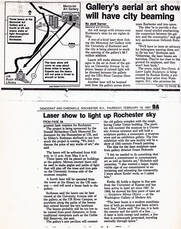
The idea for the laser sculpture came from gallery director Grant Holcomb.
“I felt we needed to do something that showed a commitment to contemporary art as well as historic art,” Holcomb said yesterday. “I also wanted a larger, highly visible sign of our commitment to entertaining and educating the community. I knew Krebs’ work, so I called him.”
Krebs, 48, holds a degree in fine arts from the University of Kansas and has been active in laser art since 1967. In 1968, he showed his first piece of laser art – Sculpture Minus Object – at the Washington Gallery of Modern Art.
“The laser beam is a modern manifestation of both an antique and basic artist’s tool: line,” Krebs said. “For me, it is both the essence and the spirit of the line. . . A laser is both energy and matter, a line that is continuously generated, traveling statically through space.”
Jack Garner, Gallery’s aerial art will have city beaming and Laser show to light up Rochester sky, 1987
Penny Knowles, Associate Director for Curatorial and Educational Affairs, Memorial Art Gallery, Rochester, NY, 1987.
Excerpts from her introduction below.
“…I think it might be helpful in your full appreciation of him, if I could tell you a little bit more about him and, what I perceive to be, his place in contemporary art.
Rockne Krebs is both a pioneer of laser art and a master of contemporary environmental sculpture.
He was one of the first artists to recognize the potential of lasers as an art tool, a modern-day counterpart to charcoal, pen or pencil for drawing in space. The first commercial laser was only available in 1960; Rockne experimented with his first indoor pieces in 1967 and since that time –some 20 years—has produced spectacular projects in cities like New Orleans, Philadelphia and his home-base in Washington, DC.
But Krebs is not exclusively interested in lasers as he would be the first to tell you. He has also worked with sun-light and star-light using prisms and ‘camera obscura’; Rockne in fact has much in common with other contemporary artists concerned with enhancing our perceptions of the environment through the manipulation of natural and artificial light: I am thinking of artists like Robert Irwin, James Turrell, Charles Ross and Dale Eldred…
His work, as you have seen it demonstrated in Neo-Green is extremely complex. Like other large-scale environmental artworks such as Christo’s Running Fence, it involves the orchestration of expensive equipment, many workers, paid and volunteer, and the negotiation of special permits…in the case from the FAA, and the City of Rochester.
The Neo-Green Crew
Despite all the preparations for Neo-Green which have extended over many months, the result is not a sure thing; because it is an artwork existing in real time, and over real-time, it is full of risk. The lasers may malfunction, the atmosphere may not be perfect (and it requires a certain amount of particulate matter to be seen). The lasers and mirrors have to be constantly adjusted, and in fact, as soon as Rockne is through with the lecture, that is exactly what he will be doing.
Finally, and this is what makes it particularly contemporary:
the work is ephemeral. It is like a stage performance which after Saturday will exist only in our memory, and in the few preparatory drawings that Rockne has created for it.
For most of us, however, the visual traces of those laser beams, delicate and evanescent in the night, weaving their web of magic over the Gallery, linking it visually and symbolically with the downtown and the University, these will be indelibly imprinted in our mind…and we will probably never experience this space without remembering them.
Monumental Drawing for Neo-Green, Memorial Art Gallery, Rochester, NY and Study for Neo-Green, Memorial Art Gallery, Rochester by Rockne Krebs, 1986.
🎼🎶🎵🎼 click for the video on Facebook and on Instagram
And now, finally, I want to introduce you to this hard-working magician, who has certainly done his part in making our reopening such a success. Please welcome…”
Penny Knowles, Associate Director for Curatorial and Educational Affairs, Memorial Art Gallery, Rochester, NY, 1987.
Don't make light of art
Laser Poetry by Ray Czapkowski
Sculpture in the Sky: Rochester will be wrapped in light in ‘Neo-Green’, Jack Garner, Democrat and Chronicle, Rochester, NY, May 1, 1987 (excerpts).
|


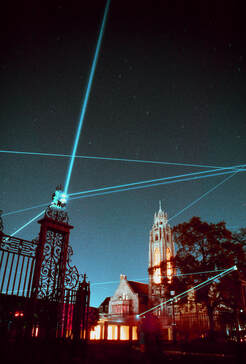
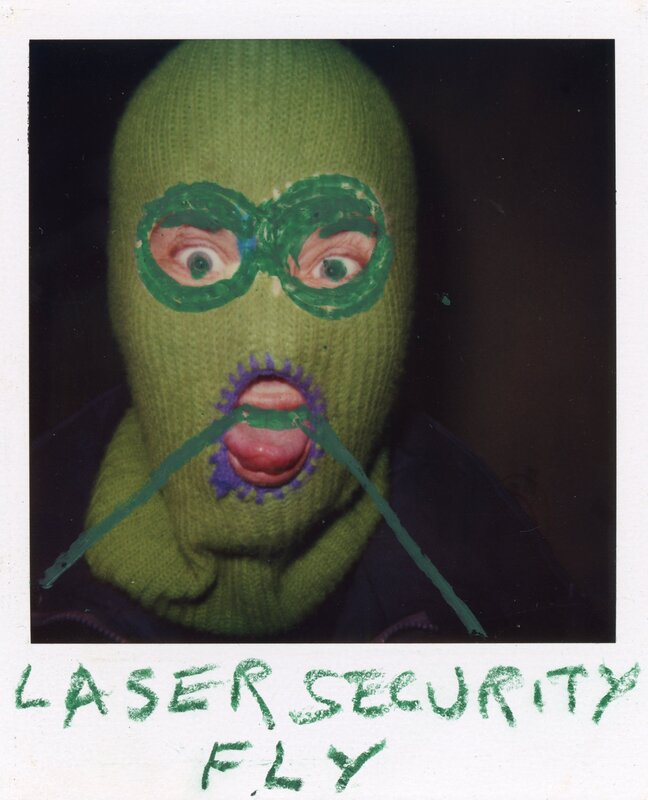
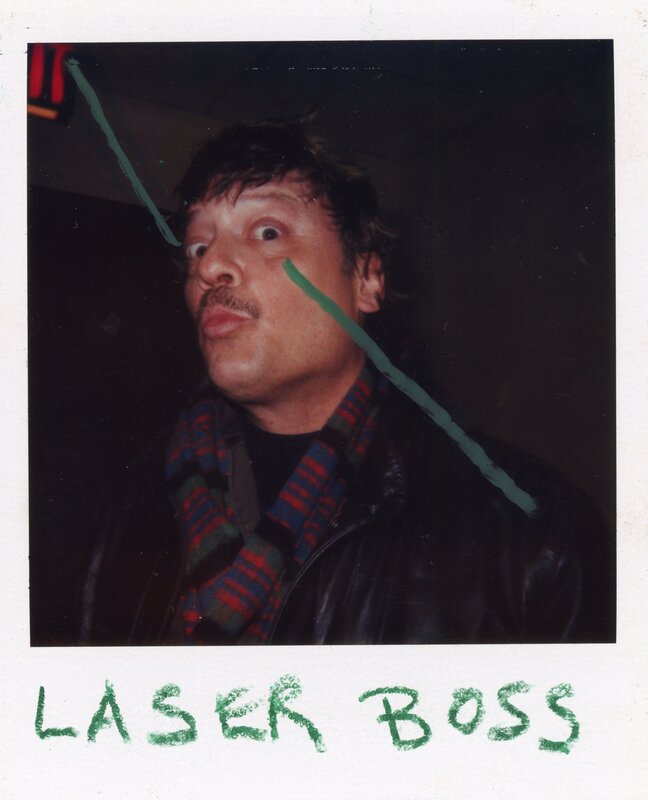
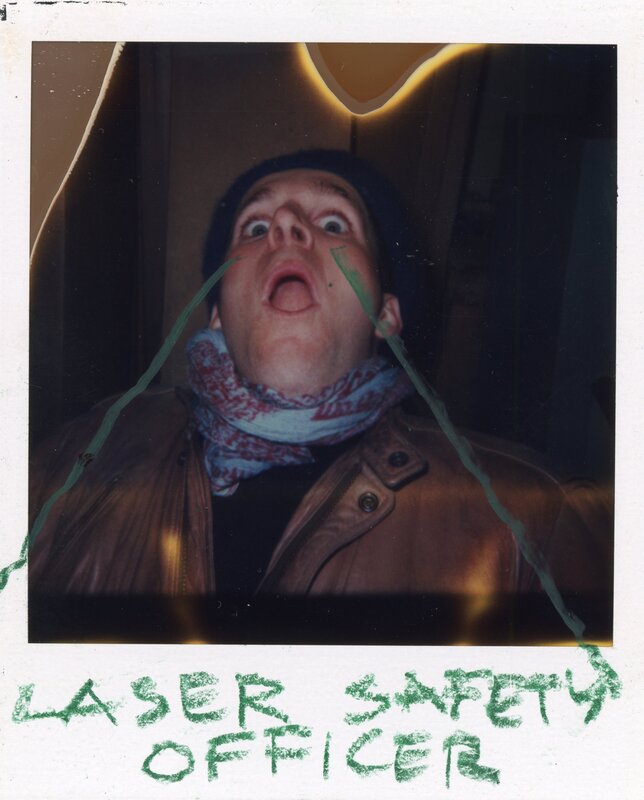
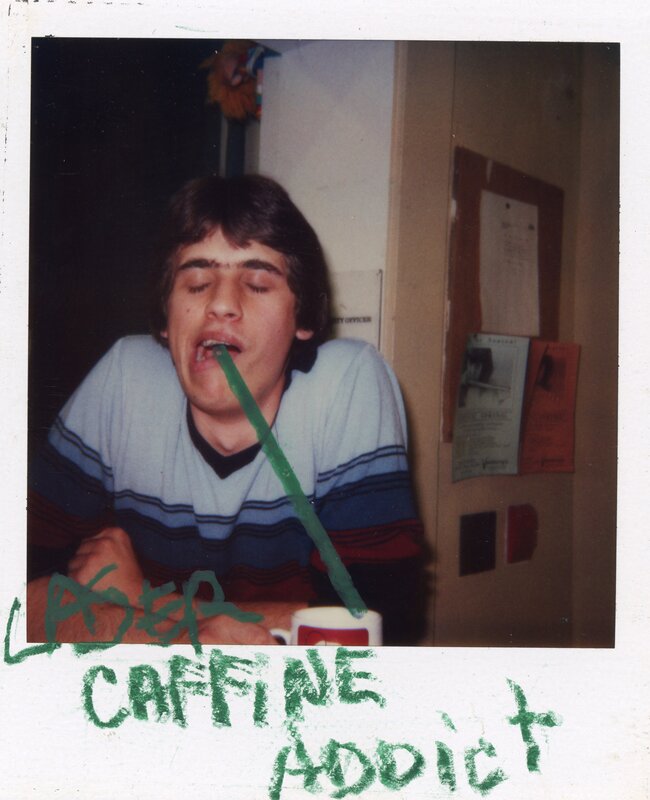
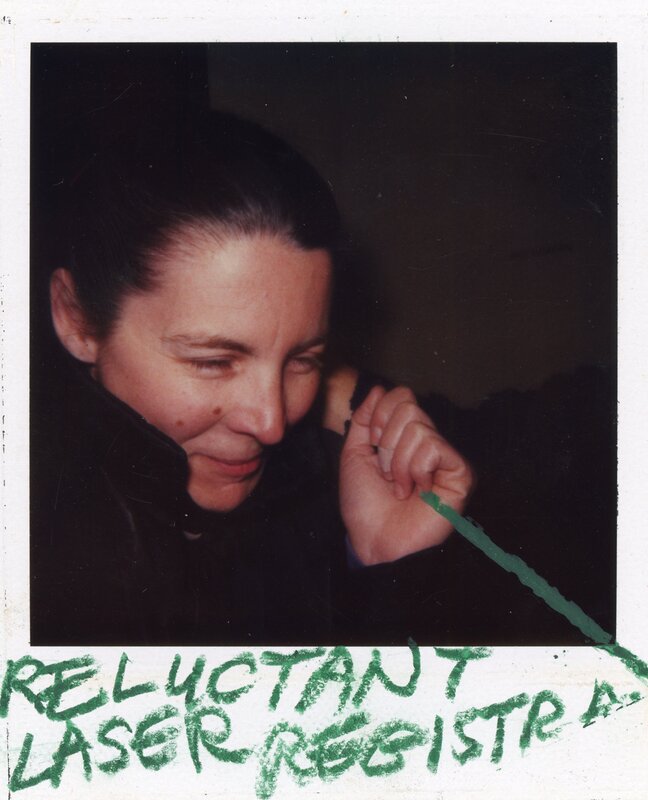

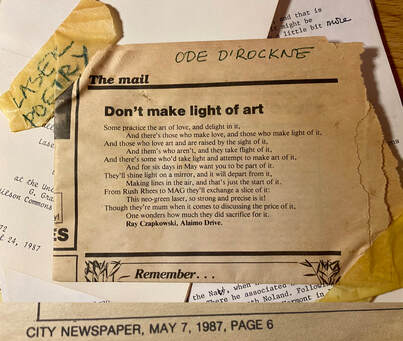
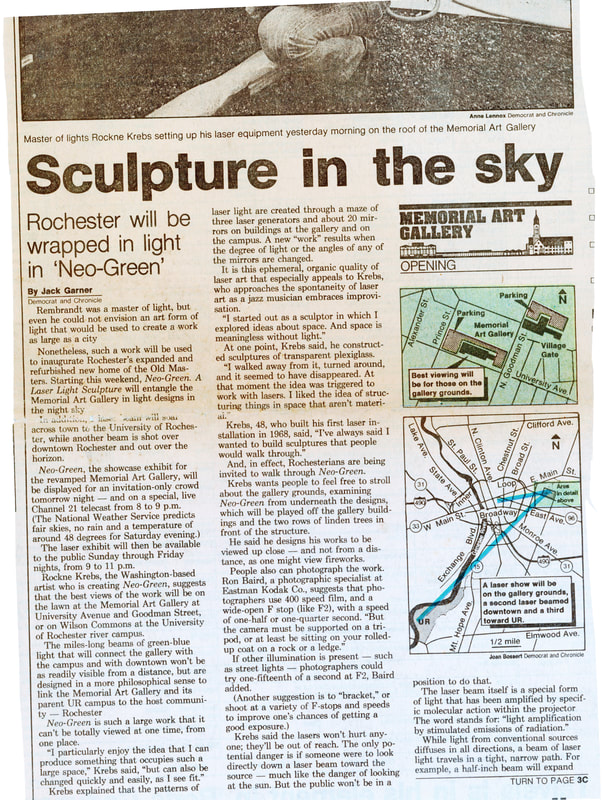
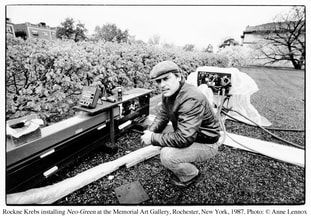
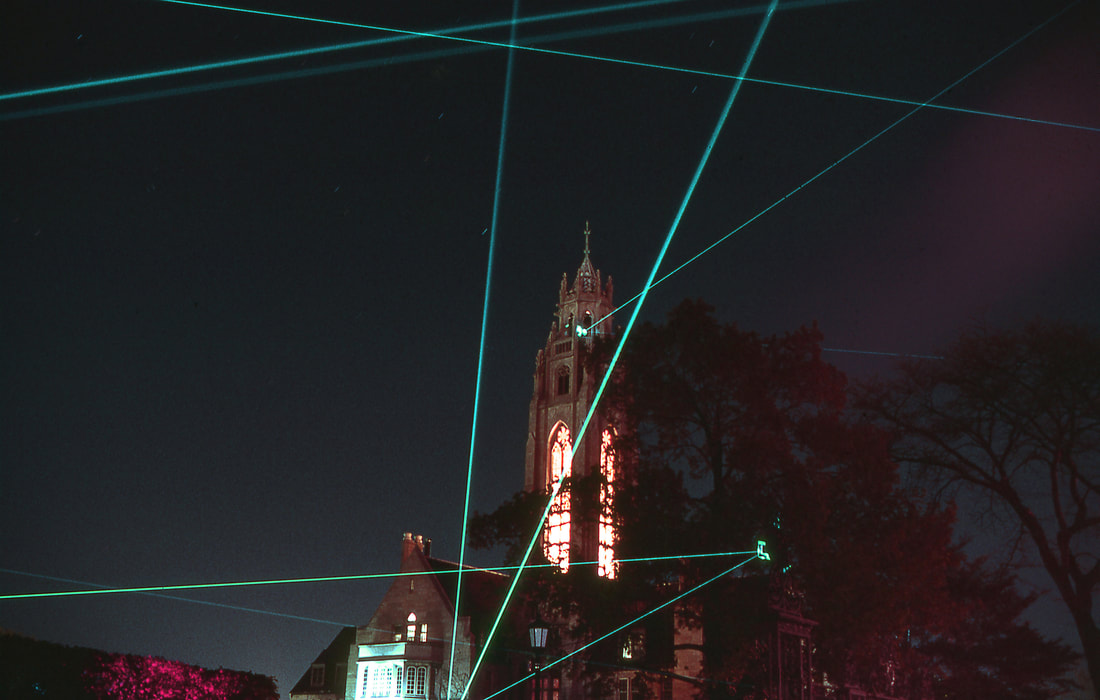
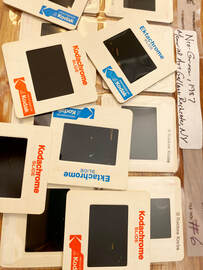
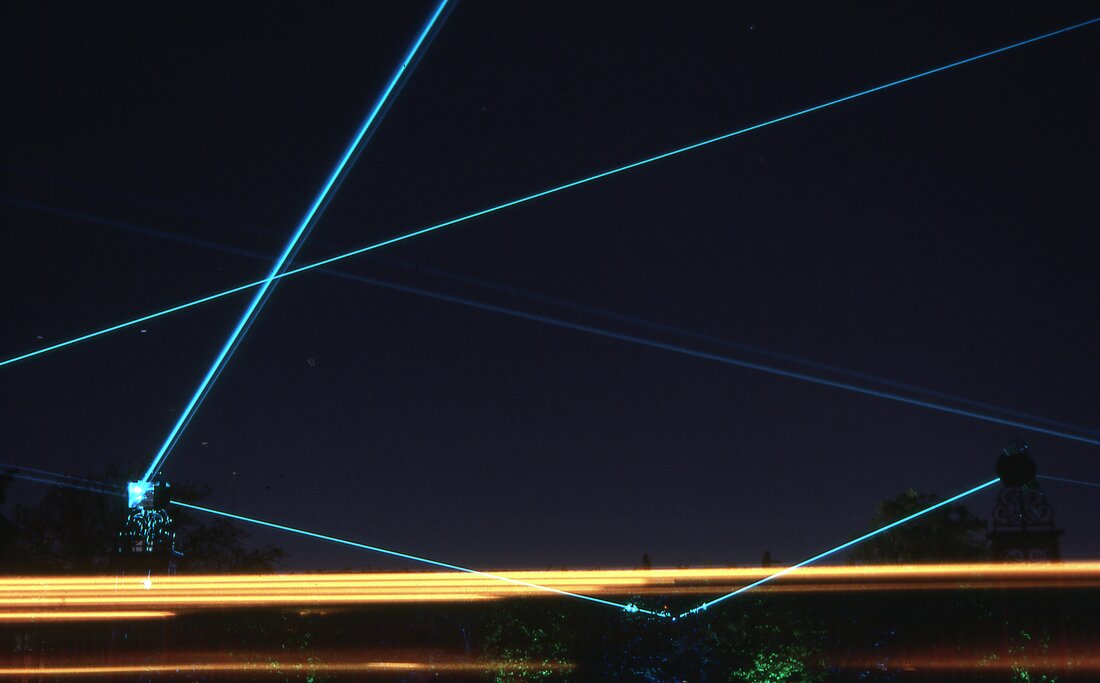
 RSS Feed
RSS Feed
